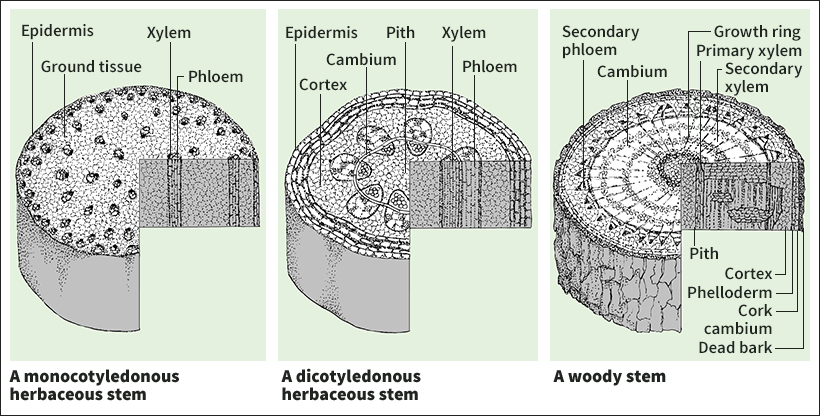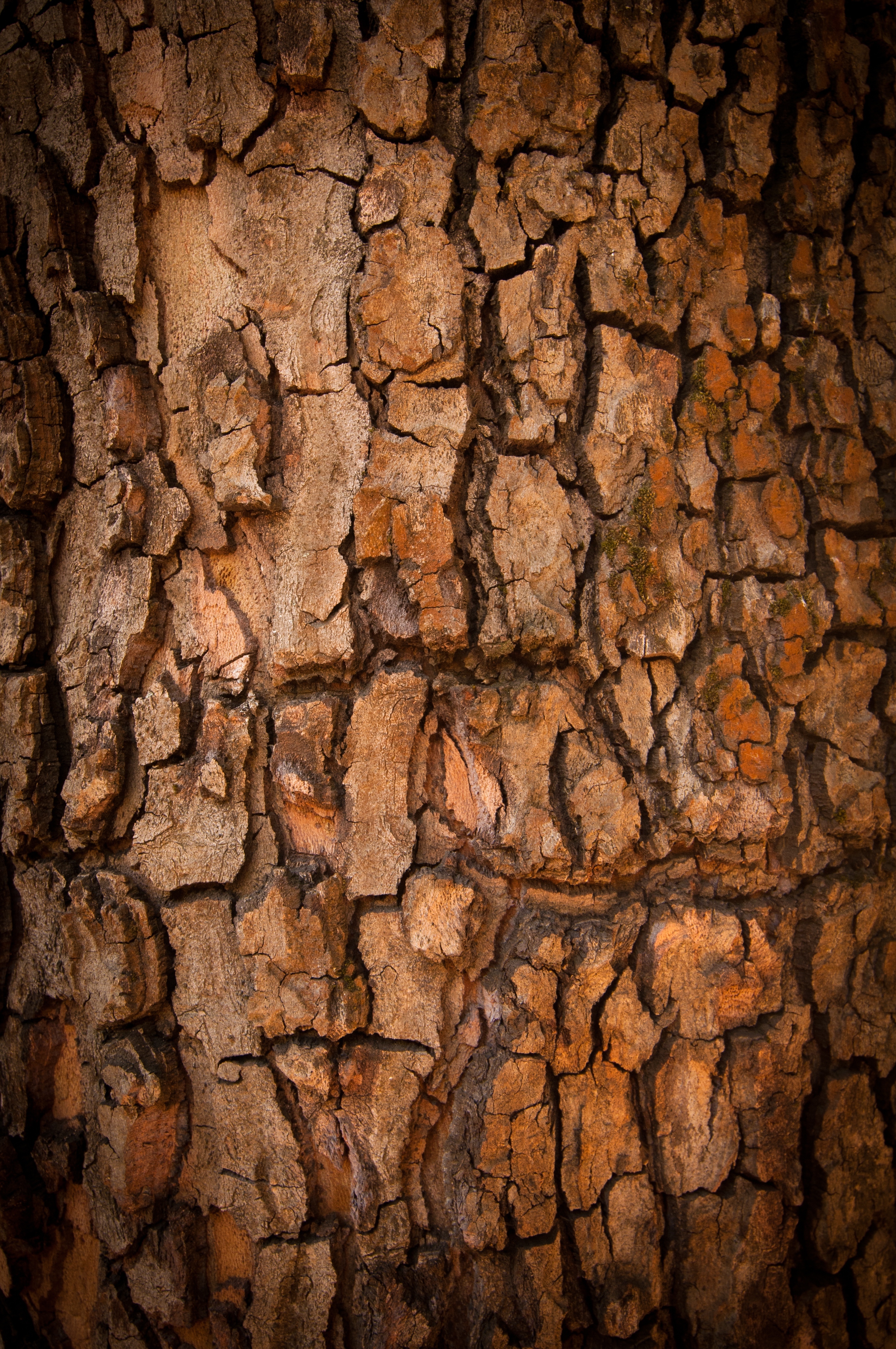Stem is the part of a plant that produces and supports the buds, leaves, flowers, and fruit. Most stems hold the leaves in a position to receive sunlight needed to manufacture food. The stem also carries water and minerals from the roots to the leaves for use in food production. In addition, the sugar made in the leaves is conducted through the stem to other parts of the plant.
All plants have stems except liverworts, hornworts, and mosses. However, the stems of various kinds of plants differ considerably in size and appearance. For example, lettuce plants have extremely short stems that are barely visible under the large leaves. California redwood trees have huge stems–their trunks–that may grow 12 feet (3.7 meters) wide and more than 350 feet (107 meters) high.
Most stems grow erect above the ground. A few kinds grow underground or horizontally along the ground. Buds develop on the stem at points called nodes and produce branches, leaves, or flowers. The space between each node is called an internode.
Kinds of stems
There are two chief kinds of stems, herbaceous stems and woody stems. Herbaceous stems have soft tissues, produce small plants, and grow very little in diameter. Most herbaceous stems live only one growing season. Such plants as roses, water lilies, alfalfa, and garden peas have herbaceous stems.

Woody stems are hard and thick. They have tough, woody tissues and may live for hundreds of years. Each growing season, woody stems develop new tissues that cause them to grow in diameter. Trees and shrubs have woody stems.
Herbaceous stems.
Herbaceous stems consist only of primary tissues. Such tissues develop as a result of cell division at the tip of the stem. Primary tissues include the epidermis, the phloem, the xylem, and the parenchyma.
The epidermis tissue forms the outer protective layer of the stem. On many stems, the epidermis has a thin waxy covering that keeps the stem from drying out. Phloem tissue includes living cells that form sieve tubes, which carry sugar down from the leaves. Xylem tissue consists mainly of dead tubes that carry water up from the roots to other parts of the plant. Parenchyma is tissue that stores food and various other substances for a plant.
Herbaceous stems differ in internal structure among various groups of plants. For example, the stems of the two largest groups of flowering plants, monocotyledons and eudicotyledons, have different structures.
Monocotyledonous stems have bundles containing both xylem and phloem scattered throughout the stem. These bundles are surrounded by ground tissue, which consists of parenchyma cells.
Eudicotyledonous stems have a circular layer of cells, called the cortex, that lies directly under the epidermis. The cortex consists mainly of parenchyma cells. Bundles of xylem and phloem are arranged in a ring beneath the cortex, with the xylem toward the inside of each bundle and the phloem toward the outside. A band of cells called the cambium runs through the bundles between the xylem and the phloem. The cambium cells are the cells that make woody stems grow wider. The cambium is not active in most herbaceous stems. The core of a eudicotyledonous stem is called the pith and consists of parenchyma cells.
Woody stems
have primary tissues that resemble those of herbaceous eudicotyledonous stems. During their first year of growth, woody stems begin to develop secondary tissues through cell division in the cambium and in tissue called the cork cambium. The secondary tissues support or replace primary tissues by producing wood and bark.

Woody stems increase greatly in diameter over time because they develop new layers of secondary tissues each year. As the stem grows in width, the epidermis and cortex are pushed outward. These tissues break up and fall away.
A cross section of a mature woody stem shows circular layers of the primary and secondary tissues. These layers, from the innermost layer to the outermost layer, are the (1) primary xylem, (2) secondary xylem, (3) cambium, (4) secondary phloem, (5) phelloderm, (6) cork cambium, and (7) cork. Secondary xylem and secondary phloem result from cell division in the cambium. Immature woody stems contain a layer of primary phloem that is destroyed as the plant grows. Phelloderm and cork are produced by cell division in the cork cambium.
Primary xylem and secondary xylem form a core of wood, which makes up the greatest part of a woody stem. During each growing season, the cambium produces a new layer of secondary xylem that can be distinguished from previous layers. The new layers are called growth rings, or annual rings. The approximate age of a stem can be determined by counting these rings.
Secondary phloem and phelloderm make up the stem’s inner bark. As new layers of secondary phloem develop, they press outward and crush the older phloem into the outer bark. The phelloderm is a layer of parenchyma cells that replaces the cortex.
Outer bark consists of cork, a hard dead tissue that replaces the epidermis as a protective covering. Stems develop new layers of cork yearly. However, the older outer bark wears away or splits apart and falls off as the stem grows wider. Therefore, the thickness of the outer bark of most woody stems does not increase greatly through the years. In the outer bark of older stems, bands of cork are alternated with bands of dead phloem that have been pushed outward by the growth of secondary phloem.
Specialized stems
Some stems perform special functions, such as food storage, reproduction, or protection or support of the plant. Such stems do not look like herbaceous or woody stems. However, specialized stems are true stems because they have nodes on their surface.
Certain specialized stems, including bulbs, corms, rhizomes, and tubers, are underground stems that can store large amounts of food. Bulbs consist of a short stem surrounded by fleshy leaves. Corms resemble bulbs but have a thicker stem and thinner leaves. Onions and tulips grow from bulbs, and gladiolus plants have corms. Rhizomes are thick stems that grow horizontally. Irises and violets have rhizomes. Tubers are short and swollen. They grow underground at the tip of the stems of such plants as potatoes.
Strawberry plants have runners, a kind of specialized stem that is active in reproduction. Runners grow horizontally along the ground and produce new plants at places where their nodes touch the surface. Grape plants and Boston ivy have modified stems called tendrils, which coil around or stick to objects, providing support for these climbing plants. The thorns of the honey locust are modified stems that protect the plant from animals.
How people use stems
Stems provide a number of foods and are used in a variety of products. Such foods as asparagus, bamboo shoots, onions, and potatoes are stems. Sugar is obtained from stems of sugar cane and sorghum. Sap from stems of maple trees is used to make maple sugar.
The wood produced by woody stems is used in the manufacture of an enormous range of products, including furniture, paper, and construction materials. Cork from the bark of the cork oak tree is used in making insulation materials, floor coverings, and bottle stoppers. Such fabrics as burlap and linen are produced from fibers in the phloem of some stems. The stems of certain trees provide substances that are used in manufacturing rubber, turpentine, and other products.
